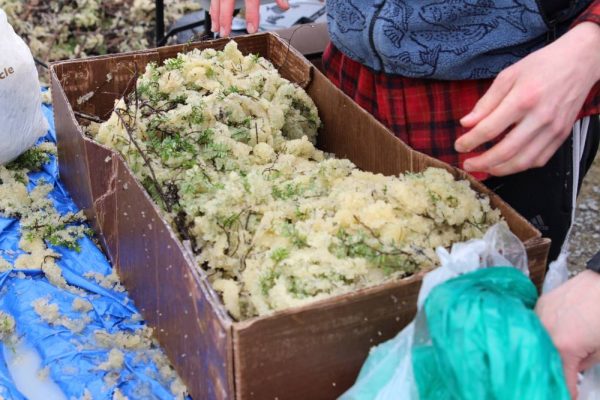
A new study reveals previously undocumented economic and cultural benefits of herring. The extensive report also highlights threats posed by the current state management plan to the subsistence herring roe fishery in Sitka Sound.
Tom Thornton, a dean and vice provost at the University of Alaska Southeast, authored the study, which was designed and funded by the Sealaska Heritage Institute.
Thornton has studied the Alaska Native subsistence herring roe harvest throughout Southeast for years, documenting its decades-long decline. The crux of his new findings is the increased importance of the Sitka fishery as stocks have disappeared elsewhere in the state.
“Herring eggs out of Sitka are a tremendously important subsistence resource,”Thornton said. “Eighty-seven percent of them on average are given away, as it were. Which is to say either shared directly or given away or traded or bartered in some way.”
Thornton found that the eggs travel throughout Alaska and even beyond, as gifts that build goodwill, reinforce social ties, and connect people to their cultural heritage.
But, Thornton says, state management of the commercial herring fishery overlooks — and even threatens — the critical and multifaceted role that the eggs play in Tlingit communities, by focusing on maximizing commercial harvest.
“And that really hasn’t worked,” he said. “It hasn’t worked to restore herring, and it’s created actually more stress on existing herring stocks particularly spawning stocks.”
The study is another chapter in what has been a turbulent year for Sitka’s herring. For only the second time in four decades, the spring commercial sac roe fishery was cancelled because the fish were too small.
And the Sitka Tribe of Alaska is taking the state to court over its management practices. The court will hear oral arguments in January, with a trial set for July. Earlier this year, Sealaska Corporation and the Central Council of Tlingit and Haida Indian Tribes submitted a joint amicus brief supporting STA.
Chuck Smythe, director of the Culture and History Department at Sealaska Heritage, helped design the study. He says he was surprised by the high percentage of the harvest that travels beyond Sitka.
“And also now with the new forms of cooperative forms of harvesting where communities send boats and have community groups come to Sitka,” Smythe said. “And then bring their harvest back and share it within the community. That’s kind of new, and that had not really been evaluated before.”
Smythe says the findings fit into the overall conflict over herring management by documenting in greater detail the social and cultural value of the eggs.
Thornton will present his findings in a lecture at the Sealaska Heritage Institute in Juneau on November 26th.
Editor’s note: The STA trial was originally scheduled for January, but earlier this month it was moved to July. Oral arguments are still scheduled for January 28th.




